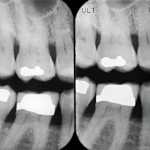
As with occlusal caries the detection and assessment of proximal caries is important for the prevention and management of caries. Visual examination is typically supported by conventional or digital radiography and other newer techniques such as light fluorescence and fibre-optic transillumination.
The aim of this review was to assess the diagnostic accuracy and reliability of commonly used caries detection methods for proximal caries diagnosis
Methods
Searches were conducted in the Medline/PubMed, and Embase databases for in-vitro and in-vivo diagnostic studies in human permanent molar teeth and published in English. The following index tests, visual examination (VE), conventional bitewing radiography (BWR), digital BWR, Laser fluorescence (LF) measurements, and fibre-optic transillumination (FOTI) were considered. Histology was the reference standard for in-vitro studies and cavity preparation or biopsy for in-vivo studies. Two reviewers independently selected studies and extracted data. Risk of bias was assessed by two reviewers independently using a specially develop set of criteria derived from the QUADAS tool.
Results
- 31 in-vitro and 5 in-vivo studies were included.
- Sensitivity, specificity and diagnostic odds ratios for caries detection in dentine for in-vitro studies are shown in the table below.
| No. of studies | Sensitivity (95%CI) | Specificity (95%CI) | Diagnostic odds ratio (95%CI) | |
| Visual exam | 1 | 0.09 (0.04–0.24) | 0.99 (0.94–0.999) | 13.26 (1.44–122.51) |
| Conventional BWR (D-speed) | 1 | 0.17 (0.07–0.40) | 0.99 (0.96–0.999) | 31.0 (3.3–291.3) |
| Conventional BWR (E-speed) | 5 | 0.67 (0.19–0.95) | 0.94 (0.71–0.99) | 31.40 (14.31– 68.93) |
| Conventional BWR (F-speed) | 3 | 0.42 (0.29–0.56) | 0.92 (0.86–0.96) | 8.7 (4.2–18.1) |
| Digital BWR (sensor) | 4 | 0.36 (0.30–0.42) | 0.95 (0.93–0.97) | 2.84 (6.56–25.13) |
| (Phosphor plates) | 2 | 0.86 (0.03–0.99) | 0.86 (0.11–0.99) | 26.06 (7.29–93.21) |
| laser fluorescence | 5 | 0.82 (0.58–0.94) | 0.81 (0.78–0.85) | 2.09 (7.01–76.04) |
- Sensitivity, specificity and diagnostic odds ratios for caries detection in dentine for in-vivo studies are shown in the table below.
| No. of studies | Sensitivity (95%CI) | Specificity (95%CI) | Diagnostic odds ratio (95%CI) | |
| Visual exam | 2 | 0.32 (0.07–0.74) | 0.76 (0.11–0.99) | 1.84 (0.03–103.47) |
| Conventional BWR (E-speed) | 1 | 0.35 (0.19–0.51) | 0.91 (0.80–0.96) | 4.8 (1.48–15.48) |
| Digital BWR (sensor) | 1 | 0.96 (0.91–0.98) | 00.50 (0.02–0.98) | 24.4 (0.44– 1359.98) |
| (Phosphor plates) | 1 | 0.83 (0.77–0.88) | 0.60 (0.20–0.90) | 7.5 (1.19–47.13) |
| laser fluorescence | 3 | 0.63 (0.58–0.68) | 0.60 (0.15–0.93) | 2.18 (0.24–19.95) |
Conclusions
The authors concluded: –
The number of diagnostic studies with low/moderate risk of bias was found to be low and indicates a need for high-quality, well-designed caries diagnostic studies. BWR and LF showed good diagnostic performance on proximal surfaces. However, because of the low number of includable clinical studies, these data should be interpreted with caution.
Comments
This review was conducted by the same group using the same methodology as the occlusal caries diagnostic review we looked at earlier (Dental Elf – 20th Oct 2021). As with the review of occlusal caries there is concern over the presence of spectrum bias particularly in relation to the vivo studies although the in-vitro studies are also affected. Above we shave shown the findings for dentine caries detection for both in-vivo and in-vitro studies. Only a small number of studies are available for some diagnostic methods and how the findings from the in-vitro studies translate to the clinical situation needs to be considered cautiously. A broader perspective can be gained from reading the recently completed a suite of Cochrane reviews on caries diagnosis (Dental Elf – 16th Jun 2021). However, a need to conduct well designed and well reported in-vivo studies of adequate size using common standards for both existing and developing diagnostic techniques is clear.
Links
Primary Paper
Janjic Rankovic M, Kapor S, Khazaei Y, Crispin A, Schüler I, Krause F, Ekstrand K, Michou S, Eggmann F, Lussi A, Huysmans MC, Neuhaus K, Kühnisch J. Systematic review and meta-analysis of diagnostic studies of proximal surface caries. Clin Oral Investig. 2021 Sep 4. doi: 10.1007/s00784-021-04113-1. Epub ahead of print. PMID: 34480645.
Other references
Dental Elf – 20th Oct 2021
Dental Elf – 16th Jun 2021
